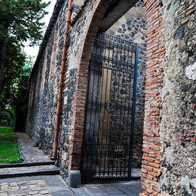The Castle of Nelson
- Massimo

- Mar 28, 2022
- 2 min read
The ideal way to follow this street is with a motorcycle, but if that is not possible one can experience the same great emotions in a car. Following the winding roads of Etna, just 62km from Taormina under the slopes of Etna is the town of Maniace with the famous Nelson Castle. If you have time, it is worth a visit to this beautiful valley in the center of Sicily.
The origins of this little village on the slopes of Mount Etna are very remote, even if you know little about his story. What is certain is that it is named after the Byzantine general Giorgio Maniace who in 1040 defeated Abdallah's Muslim troops in order to regain Sicily.
Throughout the Middle Ages, this street was the most important artery of penetration in the interior of the island with numerous fortifications along its entire route. It served as the passage for Pellegrini but also for kings and nobles with their armies.
Here, bloody battles took place between the Normans and the Arabs, with the famous Grand Count Ruggero.
Contessa Adelaide from Monferrato came to get married to Count Ruggero, bringing a very big colony of people from north Italy known as Lombardy, increasing the local population. With their arrival came also their culture and their language. They were employed to defend the island first under William the Norman and then under Tancredi.
Among the most important events to be noted, in 1089 Pope Urban II stopped in this remote village and for him it was a joy to find a Christian witness, perhaps the last in that pagan and Arab territory, in the beautiful picture of the still-existing Virgin, revered in that small chapel erected by the Byzantine General in perpetual memory of his victory and left to the inhabitants as the protector of those homes that would have since taken his name. He prostrated himself in front of the sacred and maternal image of the Madonna under the title of "Mother of God" and invoked her motherly help for his enterprise, in order to obtain from the conqueror the restoration of Christian life and hierarchy on the island.
For the first time, the Catholic Church of Rome granted to a sovereign ruler many administrative privileges, among which included the ability to manage bishops, the financial assets of the dioceses and the establishment of a metropolis. A singular institution that is in the hands of rebellious rulers, guided solely by their interest or by the reason of state or often by arbitration, creating so many disagreements over the centuries.
In 1172 Queen Margherita, the mother of Guglielmo II, called il Buono, founded a Benedictine abbey dedicated to Santa Maria (also called Ducea of Nelson, Nelson Castle and Ducea of Maniace). The building is located on the border between the municipalities of Bronte and Maniace, in the province of Catania. It was founded by Queen Margaret of Navarre, wife of William I of Sicily. It was donated perpetually to the feud (15,000 acres of land) in 1799 by King Ferdinand I of the Two Sicilies to the English Admiral Horatio Nelson for his gratitude for repressing the so-called Parthian Republic by saving his life and kingdom. Today the complex has been transformed into a museum.















Comments